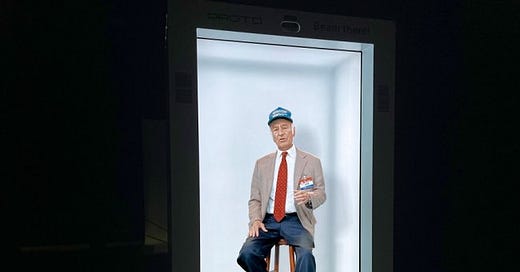Sam Walton lives on in the Walmart Museum in Bentonville, Arkansas. Walton, the famous founder of the world’s largest retailer, died in 1992. He was one of the few business leaders that achieved celebrity status and is still revered by many people who follow his business principles and appreciate his commonsense approach to most things in life.
Interactive video provider Storyfile worked with Proto, the hologram box company, to bring Mr. Walton back to life for the Walmart Heritage Group. Voicebot’s Eric Schwartz wrote of the exhibit:
The Walton model is embedded in the Proto hologram, pulling relevant responses from the recorded videos but mimicking how he spoke and moved. Proto’s 4K hologram unit shows a lifesize reproduction of Walton sitting on and occasionally standing near a stool as though in a small closet. The hologram can speak about his philosophy on the company’s values, his business style, and the early history of the company. StoryFile has previously pitched its videos as a way to preserve memories of people and events for the future, as well as a way for businesses to create new interactive training and marketing videos.
You can see a short video of the hologram in action below.
Scarcity
We often highlight where synthetic media adoption is fueled by automation and the resulting productivity gains. When it comes to “celebrity" digital twins, the real driver is scarcity. Digital Walton, as his hologram is known, fulfills that most profound form of scarcity, the complete absence of the deceased. Many people like to compare digital twins with their human counterparts. But what if all you have is the digital twin?
“Conversational video is a cutting-edge technology that enables visitors to the Walmart Museum to get a feeling of what it would be like to ask Sam Walton ‘directly’ questions about Walmart’s heritage. It’s educational, inspirational and very engaging.”
Those are the comments of Walmart Heritage Group senior director Alan Dranow. The scenario is not new. Uneeq has created a Digital Einstein, which you can see below. And the founder of Storyfile brought an AI version of his mother to her own funeral.
These are all different use cases, and they cannot fully replicate the human their human clone. However, they can provide a sense of what that person was like and potentially do that in higher fidelity than words, photographs, or videos alone.
The other form of scarcity that digital twins fulfill is time. This is for living celebrities or well-known figures that would like to extend their reach. Digital Jack is the digital twin of golfer Jack Nicklaus created by Soul Machines. The digital version is more than 40 years younger than the real thing and is able to offer fan engagement with a facsimile of the golfer. It is also able to do so when Nicklaus himself is not available.
Not long ago, virtual humans were expected to be the face of call center bots. However, the most interesting virtual human adoption trend right now is the celebrity digital twin. Call centers have other ways to fulfill customer needs. Time-starved celebrities often cannot meet all of the demands on their time without replicating themselves. Digital twins offer the potential to augment the way a celebrity distributes their time. You should expect to see more announcements in this category very soon. A couple of high-profile projects are nearing their launch.
Most of these will not be holograms, though the Proto box does add some real interest for physical settings. The vast majority will wind up first on websites and mobile apps, though celebrities gracing in-store kiosks seems inevitable.
Interest
The inevitability factor is driven by everyday consumer interest in celebrities. As virtual human technology has improved, consumers have become more willing to watch and interact with synthetic people in certain contexts. News, education, and training are some notable use cases. However, few people will not go out of their way to engage with a virtual human.
That motivation changes when it is an admired celebrity. Since consumers typically do not have access to celebrities, the option of a digital twin can be attractive. That will be another catalyst for digital twin adoption by celebrities and advertisers.
Show Me the Money
Right now, fan engagement is the dominant digital twin use case. Very soon, you should expect to see digital twins grace advertising and promotional materials with regularity. This is already being done in South Korea with the country’s highest-profile soccer (i.e. football) star using a digital twin created by DeepBrainAI. When you can effectively generate more time to make money, it is bound to drive adoption.
Creating more efficiency, overcoming scarcity, responding to consumer demand, and generating revenue are all objectives that Sam Walton himself would approve of. Call in the clones. They are perfectly aligned with celebrity culture and business incentives.






